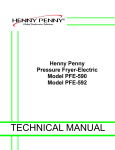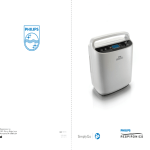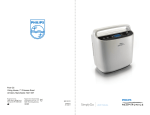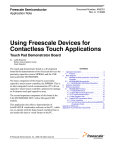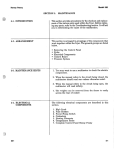Download Henny Penny 590 User's Manual
Transcript
Model 590/592 SECTION 2. MAINTENANCE 2-1. INTRODUCTION This section provides checkout and replacement procedures, for various parts of the fryer. Before replacing any parts, refer to the Troubleshooting Section to aid you in finding the cause of the malfunction. 2-2. MAINTENANCE HINTS 1. A multimeter will help you to check electric components. 2. When the manual refers to the circuit being closed, the multimeter should read zero unless otherwise noted. 3. When the manual refers to circuit being open, multimeter should read infinity. Do not move fryer with hot shortening in the frypot or filter pan. Severe burns can result from splashing hot shortening. 4. Remove weights from frame to easily access rear of fryer. 2-3. PREVENTIVE MAINTENANCE To ensure a long life of fryers and their components, regular maintenance should be performed. Refer to the chart below. Procedure Frequency Filtering of shortening See KFC’s Standards Library Changing of shortening See KFC’s Standards Library Changing the filter envelope See KFC’s Standards Library Cleaning deadweight assy. Daily-See Deadweight Valve Section Cleaning the frypot See KFC’s Standards Library Reversing lid gasket Each 90 Days-see Reversing Lid Gasket Section Lubricate rear lid rollers Annually-See Lubricating Lid Rollers Section Cleaning safety relief valve Annually-See Removal/Cleaning of Safety Relief Valve Section 307 2-1 Model 590/592 2-4. HIGH TEMPERATURE LIMIT CONTROL This high temperature control is a safety, manual reset control, which senses the temperature of the shortening. If the shortening temperature exceeds 425°F (218°C), this switch opens and shuts off the heat to the frypot. When the temperature of the shortening drops to a safe operation limit, manually reset by pressing the red reset button. The red reset button is located under the control panel, in the front of the fryer, to the right of the drain. Once reset, the frypot starts heating. Checkout Before replacing a high temperature limit control, check to see that its circuit is closed. The shortening temperature must be below 380°F (193°C) to accurately perform this check. 1. Remove electrical power supplied to the fryer. To avoid electrical shock or property damage, move the power switch to OFF and disconnect main circuit breaker, or unplug cord at wall receptacle. 2. Remove the control panel. 3. Remove the inner heat shield. 4. Remove two nuts securing the high limit bracket to unit, and pull the bracket from the unit. 5. Remove two screws securing the high limit to the bracket, and remove the high limit from the bracket. 6. Remove the two electrical wires from the high temperature limit control. 7. Manually reset control, then check for continuity between the two terminals after resetting the control. If circuit is open, replace control, then continue with this procedure. (If the circuit is closed, high limit is not defective. Reconnect the two electrical wires.) 2-2 1103 Model 590/592 2-4. HIGH TEMPERATURE LIMIT CONTROL (Continued) To avoid electrical shock of property damage, move the power switch to OFF and disconnect main circuit breaker, or unplug cord at wall receptacle. Replacement 1. If the tube is broken or cracked, the control will open, shutting off electrical power. The control cannot be reset. 2. Drain shortening from the frypot and discard. A substance in the tube could contaminate the shortening. 3. Remove control panel. 4. Loosen small inside screw nut on capillary tube. 5. Remove capillary bulb from bulb holder inside the frypot. 6. Straighten the capillary tube. 7. Remove larger outside nut that threads into pot wall, and remove defective control from control panel area. 8. Insert new control and replace screws. 9. Uncoil capillary line, starting at capillary tube, and insert through frypot wall. To avoid electrical shock or other injury, run capillary line under and away from all electrical power wires and terminals. The tube must never be in such a position where it could accidentally touch the electrical power terminals. 10. Carefully bend the capillary tube as shown in photo and place into bulb brackets. 1103 2-3 Model 590/592 2-4. HIGH TEMPERATURE LIMIT CONTROL (Continued) 11. Pull excess capillary line from pot and tighten nut into frypot wall. Be sure capillary bulb of high limit is positioned so it does not interfere with carrier or get damaged when cleaning frypot. 12. With excess capillary line pulled out, tighten smaller nut. 13. Replace inner and front panels. 14. Refill with shortening. 2-5. FUSE HOLDERS There are two fuse holders on each model of the electric fryers. To check or change fuse, unscrew black fuse holder cap. To avoid electrical shock or property damage, move the power switch to OFF and disconnect main circuit breaker, or unplug cord at wall receptacle. Checking Procedure for Fuse Holders CONTROL PANEL FUSES 3 Phase Remove the control panel and pull the wires from the fuse holder terminals. Using a multimeter or continuity light, check across the terminals. The circuit should be closed. If not, replace the fuse (HP# EF02-007) or fuse holder (HP# EF02-006). 2-4 1103 Model 590/592 2-6. POWER/PUMP SWITCH The POWER/PUMP switch is a three way rocker switch with a center OFF position. With switch in the POWER position, the fryer operates. With switch in PUMP position, the filter pump operates, but the unit will not heat. To avoid electrical shock or property damage, move the power switch to OFF and disconnect main circuit breaker, or unplug cord at wall receptacle. Checkout 1. Remove control panel. 2. Label and remove wires from the switch. 3. OFF position-should be open circuit anywhere on switch. 4. Power position. Check from: #5 to #6 closed circuit #l to #2 closed circuit 5. Pump position. Check from: #4 to #5 closed circuit #3 to #2 closed circuit Check across the jumpers on the wires of POWER/PUMP switch. These jumpers have resistors and capacitors which may be faulty. Replacement 1. With control panel removed, and wires off of the switch, push in on tabs on the switch to remove from the panel. 2. Replace with new switch, and reconnect wires to switch following the wiring diagram. 3. Replace the control panel. 1103 2-5 Model 590/592 2-7. TEMPERATURE PROBE REPLACEMENT The temperature probe relays actual shortening temperature to the control. If it becomes disabled, “E06” will show in the display. Also, if temperature is out of calibration more than 10°F, or 10°C, the temperature probe should be replaced. An Ohm check can be performed also. See chart at end of this section. 1. Remove electrical power supplied to the fryer. To avoid electrical shock or property damage, move the power switch to OFF and disconnect main circuit breaker, or unplug cord at wall receptacle. 2. Drain the shortening from the frypot. 3. Remove the control panel. 4. Using a 1/2” wrench, remove the nut on compression fitting. Figure 2-1 5. Remove the temperature probe from the frypot. 6. Place nut and new ferrule on new temperature probe and insert temperature probe into compression fitting until it extends one-half (1/2) inch (1.3 cm) into frypot. Use temperature probe gauge provided in temperature probe kit, to ensure proper placement in frypot. See Figures 2-1 & 2-2. 7. Tighten hand tight and then a half turn with wrench. Figure 2-2 Excess force will damage temperature probe. 8. Connect new temperature probe to PC board and replace control panel. 9. Replace shortening. 10. Turn power on and check out fryer. 2-6 407 Model 590/592 2-8. COMPLETE CONTROL PANEL-HENNY PENNY Should the control panel become inoperative, follow these instructions for replacing the board. 1. Remove electrical power supplied to the fryer. To avoid electrical shock or property damage, move the power switch to OFF and disconnect main circuit breaker, or unplug cord at wall receptacle. 2. Remove the two screws securing he control panel and lift panel up and out 3. Unplug the connectors going to the control board. 4. Install a new control panel. 2-9. PRESSURE REGULATION The Henny Penny Fryer uses pressure as one of the components of the cooking process. Once the lid is sealed to the frypot, and the solenoid valve closes, a deadweight valve maintains the correct pressure in the frypot. The lid has minimal and limited maintenance and repair procedures, which are addressed in the following sections. The following is a routine maintenance schedule for the Lid: Every 90 days • Clean and reverse the lid gasket Yearly Inspection • Check Lid Gasket for splits and tears-replace if necessary 1103 • Check Pressure Pads for wear-rotate if necessary • Check Cam Slide Guides-replace if worn or broken • Check Lid Rollers-replace if cracked or damaged 2-7 Model 590/592 2-10. TILTING THE LID UPRIGHT The Lid Assembly is easily tilted up for cleaning or servicing. 1. Raise the lid and remove racks and carrier. 2. Grasping the lid handle, lift the front of the lid up until it stops in an upright position. Be sure the metal arm on the left side of the lid is in the vertical position holding lid upright, or severe injuries could result. (See photo at left). 2-11. REVERSING THE LID GASKET The gray rubber gasket surrounding the inside of the lid is designed to be reversed. Because of heat expansion and the pressure used for cooking process, gasket is constantly under extreme stress. Reversing the lid gasket will help to assure that the fryer will not lose pressure through leakage. 1. Put the lid in the upright position, as previously described. 2. Using a thin blade screwdriver, pry out the gasket at the corners. Remove the gasket. Check the gasket for any tears or nicks. If the gasket is damaged it needs to be replaced. Be sure the metal arm on the left side of the lid is in the vertical position holding lid upright, or severe injuries could result. (See photo in Tilting Lid Upright section) 3. Clean the gasket and gasket seat with hot water. 4. Rotate the gasket with the opposite side facing out. Install the 4 corners of the lid gasket. Smooth gasket into place, working from the corners towards the middle of each side. 2-8 1103 Model 590/592 2-12. LID COUNTERWEIGHT CABLES The Lid Counterweight in the back of the fryer balances the weight of the lid system to allow easier opening and closing of the lid. The weight has two cables attached to it, and weighs about 150 lbs. (67.5 Kg). 1. Using a 3/8” socket, remove the nuts securing rear shroud of the fryer and remove the shroud. 2. Using Phillips-head screwdriver, remove screws securing the top cap and remove cap. 3. Raise the lid. 4. Unscrew broken cable from the weight assembly and the bracket attached to the fryer, and remove broken cable. 5. Screw a 5/16” nut on each end of the new cable. 6. Using a wrench, screw new cable into the weight assembly until tight. 7. Using a 1/2” wrench, tighten nut (already threaded on the cable) against weight assembly, securing the cable into the weight assembly. 8. Pull cable over pulley and down behind weight assembly. 9. Insert cable into the hole in the bracket and screw a 5/16” nut onto end of cable. Tighten cable, by screwing the cable through this nut until the weight assembly becomes level. The safety cable should now have slack in it with the weight assembly level. 10. Tighten nut against the top of the bracket, securing the cable. 11. Replace the top cap and rear shroud. The repair is now complete. 1103 2-9 Model 590/592 2-13. PRESSURE PAD The pressure pads are plastic strips that the lid cam presses against to seal the lid. 1. Raise the lid. 2. Remove the 4 screws securing the lid cover and remove cover. 3. Push the lid cam back, off of the pressure pads. 4. Using an Allen wrench, remove the large bolt securing the pad. 5. Using a Phillips head screw driver, remove the small screw securing the pad and remove the broken pad. If the pressure pad is worn, but not broken, it can be reversed 180 degrees, and the other end of the pad used. 6. Install new pad in reverse order. 2-10 1103 Model 590/592 2-14. LID ADJUSTMENT If steam leaks out from around the lid gasket, the pressure pads could be worn or broken. If the pressure pad is worn, but not broken, it can be reversed 180 degrees, and the other end of the pad used. See Pressure Pad Section. If steam leaks, check for: • • • • Pressure pad wear Cracked or worn gasket Gasket installed improperly Fryer operating above 12 psi (827 mbar) Fryer should be operating at 12 psi, or serious burns could result. 1103 2-11 Model 590/592 2-15. SOLENOID VALVE This is an electro-mechanical device that causes pressure to be held in the frypot. The solenoid valve closes at the beginning of the Cook Cycle and opens automatically at the end of the Cook Cycle. If this valve should become dirty, or the Teflon seat nicked, pressure will not build up. The electric fryer uses a 208/240 volt 60 hertz coil (50 hertz internationally). To avoid electrical shock or property damage, move the power switch to OFF and disconnect main circuit breaker, or unplug cord at wall receptacle. Coil Check Procedure Remove the solenoid wires from the wire nuts which are found behind the control panel. Check across wires. RESULTS 208/240 Volt, 60 Hertz 150 Ohms 208/240 Volt, 50 Hertz 230 Ohms Replacement 1. Remove the right side panel. 2. Remove the “tru-arc” retaining clip on top of coil housing. 3. Remove the cover. 4. If only the coil is to be replaced, disconnect two coil wires at wire nuts in the coil housing. Remove coil, insert new coil, and connect wires at wire nuts. Assemble in reverse order of disassembly. The wires may be connected in any order. 2-12 1103 Model 590/592 2-15. SOLENOID VALVE (Continued) 5. If the core-disc assembly is sticking due to buildup of shortening, breading, and food particles, proceed with the following steps: a. Unscrew the solenoid bonnet assembly from solenoid valve body. b. Remove solenoid bonnet assembly and bonnet gasket. c. Remove the core-disc assembly, core spring retainer, and the core spring. d. Wash all these parts in hot water. If Teflon seals need to be replaced, proceed to Step 6; otherwise, assemble in reverse order of disassembly. Assemble valve core and blade with smooth side and rounded edge of blade toward the disc spring guide. 6. Repair kit, Part No. 17120, is available if any of the seals must be replaced. If one seal is defective, replace all seals. Solenoid body must be removed from the fryer for replace ment of seals. Continue on to step 7. 7. Loosen wires on the strain relief and pull the wires through the relief. 8. With the bonnet assembly and core-disc assembly removed, disconnect the two nut fittings. One connects the solenoid valve to the deadweight, the other is attached to the condensation tank. 9. Remove the elbows from the solenoid valve. 10. Remove the two adapter screws which attach the pipe adapter to the solenoid valve body. 11. Remove the disc spring, guide, and Teflon seat. 12. Clean the valve body. 1103 2-13 Model 590/592 2-15. SOLENOID VALVE (Continued) 13. Wet “O” ring around seat with water and insert O-ring assembly (flat side first) in valve through “IN” side of body. Use an eraser end of pencil and press in the Teflon seal until it snaps into place. Be careful not to mar or nick the seat. The smallest nick can cause a pressure leak. Replace all O-ring seals that are in the parts kit and reassemble the valve. 14. If the complete valve is to be replaced, follow steps 1, 2, 3, 4, 5, 7, 8 and 9 in this section. 2-16. DEADWEIGHT VALVE DO NOT ATTEMPT TO REMOVE DEADWEIGHT CAP WHIILE FRYER IS OPERATING. SEVERE BURNS OR OTHER INJURIES WILL RESULT. The operating valves are located behind the lid. The valve, left of the pressure gauge, is a 14 1/2 lb. (999 mbar) safety relief valve, and the one on the right is the deadweight valve. Deadweight valve 2-14 Valves are working properly, when the pointer on the gauge is in the “OPERATING ZONE” (green area). The gauge pointer should not normally exceed the operating zone. If the pressure builds to 14 1/2 lbs.(999 mbar), the safety relief valve will open to release steam pressure from inside frypot. 1103 Model 590/592 2-16. DEADWEIGHT VALVE (Continued) DO NOT PULL THE RING ON THE SAFETY RELIEF VALVE. HOT STEAM WILL BE RELEASED AND SEVERE BURNS WILL RESULT. ORIFICE CAP DEADWEIGHT 1. At the end of each day’s usage of the fryer, the deadweight valve must be cleaned. The fryer must be OFF and pressure released. Open the lid and then remove the deadweight valve cap and deadweight. Failure to clean the deadweight assembly daily could result in the fryer building too much pressure. Severe injuries and burns could result. 2. Wipe both the cap and weight with a soft cloth. Make certain to thoroughly clean inside cap, the weight seat, and around deadweight orifice. 3. Dry the parts and replace immediately to prevent damage or loss. 2-17. REMOVAL & CLEANING OF SAFETY RELIEF VALVE The safety relief valve should be cleaned once a year. SAFETY RELIEF VALVE DO NOT ATTEMPT TO REMOVE SAFETY VALVE WHILE FRYER IS OPERATING, OR SEVERE BURNS OR OTHER INJURIES WILL RESULT. 1. Remove pressure gauge. 1103 2-15 Model 590/592 2-17. REMOVAL & CLEANING OF SAFETY RELIEF VALVE (Continued) 2. Use a wrench to loosen the valve from the pipe tee, turn counterclockwise to remove. 3. Clean the inside of the pipe tee with hot water. Turn the safety relief valve towards the rear of the fryer when reinstalling safety relief valve. 4. Immerse the safety relief valve in a soapy water solution for 24 hours. Use a 1 to 1 dilution rate. The valve cannot be disassembled. It is factory preset to open at 14 1/2 pounds of pressure. If it does not open or close, it must be replaced. DO NOT DISASSEMBLE OR MODIFY THIS VALVE. TAMPERING WITH THIS VALVE COULD CAUSE SERIOUS INJURIES AND WILL VOID AGENCY APPROVALS AND APPLIANCE WARRANTY. 2-18. PRESSURE GAUGE Calibration Steps The pressure gauge can be recalibrated should it be out of adjustment. 1. Remove the rim and glass. 2. If the indication hand shows a pressure or vacuum reading when it should stand at “0”, turn the recalibrator screw in the same direction in which the indicating hand is to be moved until the hand stands a proper “0” position. 3. Replace the rim and glass. Adjusting Screw Cleaning Steps 1. Remove the gauge and check inside the pipe fittings from deadweight body. Make certain fittings are clean and open. 2. Clean and reinstall the gauge. 2-16 1103 Model 590/592 2-19. CONTACTORS The electric fryer requires two switching contactors: a primary and a heat contactor. The primary contactor energizes (contacts close) any time the POWER/PUMP switch is in the POWER position, and the temperature of the shortening is below 420° F ( 215° C). The high limit cuts power at the primary contactor if the temperature of the shortening is above 420° F ( 215° C). The primary contactor supplies power to one side of the heat contactor. Primary The heat contactor is controlled by the computer controller. When the controller calls for heat, the heat contactor applies power to one side of the heating elements. When the heat contactor and primary contactor are energized (contacts closed) the electric heating elements heat the shortening. The photo shows a mercury heat contactor, but CE countries will have an electromechanical heat contactor. Heat 30 31 32 Checkout 1. Remove electrical power supplied to the fryer. To avoid electrical shock or property damage, move the power switch to OFF and disconnect main circuit breaker, or unplug cord at wall receptacle. 2. Remove the control panel. 34 1103 35 36 3. Label and remove wires from contactors and perform a check on both contactors as follows: Test Points Results From 23 to 29 open circuit From 24 to 28 open circuit From 25 to 27 open circuit From 30 to 34 open circuit From 31 to 35 open circuit From 32 to 36 open circuit From 33 to 37 ohm reading 1700 From 22 to 26 ohm reading 415 2-17 Model 590/592 2-19. CONTACTORS (Continued) To avoid electrical shock, make connections before applying power, take reading, and remove power before removing meter leads. The following checks are performed with the wall circuit breaker closed and the main power switch in the ON position. 4. With power reapplied and in a heat-up mode, check the power going to both contactor coils. This is to be sure power is going to the contactors. If no voltage is found going into the primary contactor coil, check wiring, high limit, and drain switch. If no voltage at heat contactor coil, check wiring and connections at PC board. Replacement If either contactor proves defective, replace as follows: To avoid electrical shock or property damage, move the power switch to OFF and disconnect main circuit breaker, or unplug cord at wall receptacle. 1. Label and remove only those wires directly connected to the contactor being replaced. Hint: Removing the left side panel may be helpful in replacing the heat contactor. 2. Remove the mounting screws on the base plate of the primary contactor and remove contactor. Proceed to step 5. 3. Remove the screws securing the mercury contactor bracket to the mounting plate and remove bracket and contactor. 4. Remove the screws securing the contactor to the bracket and remove contactor from bracket. 5. Install new contactor in reverse order. 6. Install control panel and reconnect power to the fryer and test for proper operation. 2-18 1103 Model 590/592 2-20. HEATING ELEMENTS The electric model fryer uses 2 heating elements. Heating elements are available in 208, 220/240, 380 and 415 volts. Check the data plate, on the shroud behind the lid, to determine the correct voltage elements. 1. Remove the electrical power supplied to the unit. To avoid electrical shock or property damage, move the power switch to OFF and disconnect main circuit breaker, or unplug cord at wall receptacle. 2. Remove the control panel. 3. Remove both side panels. 4. Remove upper screws and loosen the lower screws, to the front control shroud, and hinge it down. (See photo at left) To avoid electrical shock, make connections before applying power, take reading, and remove power before removing meter leads. The following checks are performed with the wall circuit breaker closed and the main power switch in the ON position. 5. Perform an amp check on one heating element at a time with the wires connected to the contactors. The 2 heaters actually have 3 small heating elements on the inside of the outer plate. It is important to check between the correct wires to obtain the accurate amp reading. The wires are labeled for your convenience. Wires L1-L3 L3-L2 L2-L1 L1-L2 L3-L2 L2-L1 1103 Power 8500W 8500W 8500W 8500W 8500W 8500W Voltage 208V 208V 208V 240V 240V 240V Amperage 47.8 47.9 48.0 39.4 40.1 39.9 2-19 Model 590/592 2-20. HEATING ELEMENTS (Continued) Replacement 1. Drain the shortening. 2. Remove the high limit bulb holder from the heating element inside the frypot. 3. Disconnect the heating element wires from the contactors. Label each so it can be replaced in the same position on the new element. 4. Remove the heat contactor, as described in Contactors Section, to access the left side element nuts. 5. Loosen the screws on the element spreaders. 6. Slide element spreaders to the center of the heating element. 7. Using a 7/8” crowsfoot, remove the brass nuts and washers which secure the ends of the elements through the frypot wall. 8. Remove the heating elements from the frypot as a group by lifting the far end, and sliding them up and out towards the rear of the frypot. Always install new rubber O-rings (2) when installing heating elements. 9. Install new heating elements with new rubber O-rings mounted on terminal ends, and spreaders loosely mounted in the center of the stacked elements. 10. Replace the heating elements, terminal end first at approximately 45º angle, slipping the terminal ends through the front wall of the frypot. 2-20 1103 Model 590/592 2-20. HEATING ELEMENTS (Continued) 10. Replace the brass nuts and washers on the heating element terminals. Tighten the brass nuts to 30 foot lbs of torque. 11. Replace heat contactor. 12. Move the element spreaders from the center of the ele ment, into a position which will spread each element apart evenly on all four sides, and tighten. 13. Replace the high limit bulb holder on the top element, and position the bulb between the top and second element midway from side to side, and tighten screw which holds the bulb in place. 14. Reconnect the wires to the appropriate terminal as labeled when they were removed. 15. Replace the front control shroud and control panel. 16. Replace side panels. 17. Connect the power cord to the wall receptacle or close wall circuit breaker. Heating elements should never be energized without shortening in the frypot, or damage to elements could result. 1103 2-21 Model 590/592 2-21. DRAIN MICROSWITCH Upon pulling out on the drain handle, the microswitch should be activated and the unit will not heat, but when the handle is pushed back, the unit should operate properly. The bracket on the microswitch is slotted so it can be adjusted backward or forward. 1. Remove electrical power supplied to the unit. To avoid electrical shock or property damage, move the power switch to OFF and disconnect main circuit breaker, or unplug cord at wall receptacle. 2. The following check should be made to determine if the drain switch is defective. a. Remove bracket from the unit. b. Remove wires from the switch. c. Check for continuity across the two outside terminals on the drain switch. If circuit is open, the Drain Switch is bad. The circuit should only be opened by pressing on the actuator of the Drain Switch. 1/8” (4 mm) Gap 3. To replace switch, remove switch from the bracket, and install switch in reverse order. 4. Test to see if drain valve handle actuates the switch. The gap between the drain switch and the shaft should be no more than 1/8” (3 mm). HINT: Listen for audible click of switch while pulling drain valve handle. 2-22 1103 Model 590/592 2-22. DRAIN VALVE AND EXTENSION The drain valve opens when the drain valve handle is pulled out and drains the shortening out of the pot. Replacement 1. Using a 3/8” socket, remove the nuts securing the drain switch bracket, and pull the bracket from the studs. 2. Remove the nut securing the drain handle and pull the handle from the drain valve. 3. Using a large adjustable wrench, unscrew the drain valve and extension from the unit. 4. Replace the drain valve and extension. 5. Replace the drain switch bracket. 6. Adjust the microswitch to be no more than 1/8” (3 mm) from the shaft of the drain valve. HINT: Listen for audible click of switch while pulling drain valve handle. 1103 2-23 Model 590/592 2-23. NYLATRON STRIPS REPLACEMENT 1. Raise the lid and remove the retention ring from one end of the lid pin. 2. Slide the lid pin from unit. 3. Lift the lid from unit. The lid weighs 80 lbs (36 kg). Take care when lifting lid to prevent personal injury. 4. Using a 3/8” socket, remove the nuts securing the rear shroud and remove shroud. 5. Using a Phillip’s-head screwdriver, remove the screws securing the top cap and remove top cap. 6. Remove the bolts securing the nylatron strips to the weight assembly and remove strips from weight assembly. 7. Using a Phillip’s-head screwdriver, remove the screws securing the front shroud. 8. Unfasten the exhaust hose from the hose clamp. 2-24 1103 Model 590/592 2-23. NYLATRON STRIPS REPLACEMENT (Continued 9. Lift the front shroud up and out, over the arm of the lid. 10. Thread the new nylatron strip through the track in the front shroud. 11. Lining up the holes in the strips, fit the front shroud back over the lid arms. 12. Secure the strips to the weight assembly. 13. Replace back shroud, top cap, and lid, and replacement is complete. 1103 2-25


























